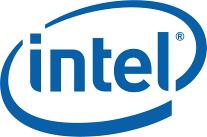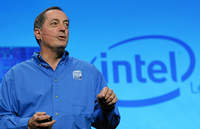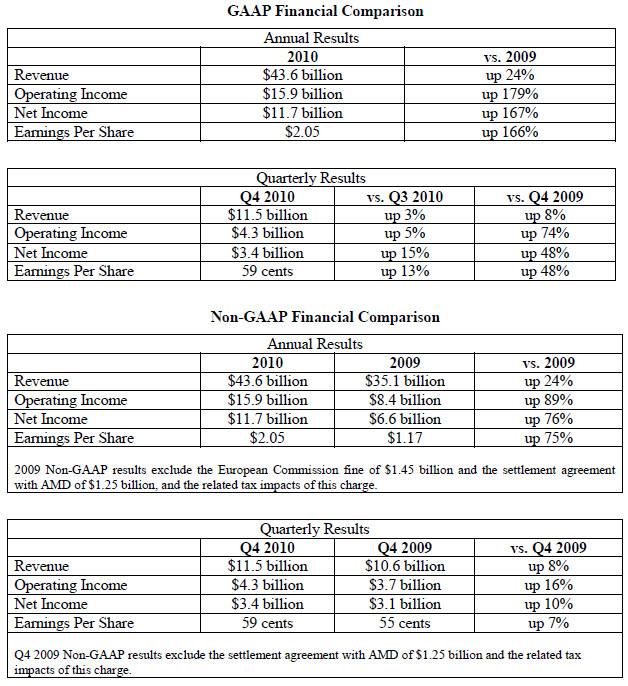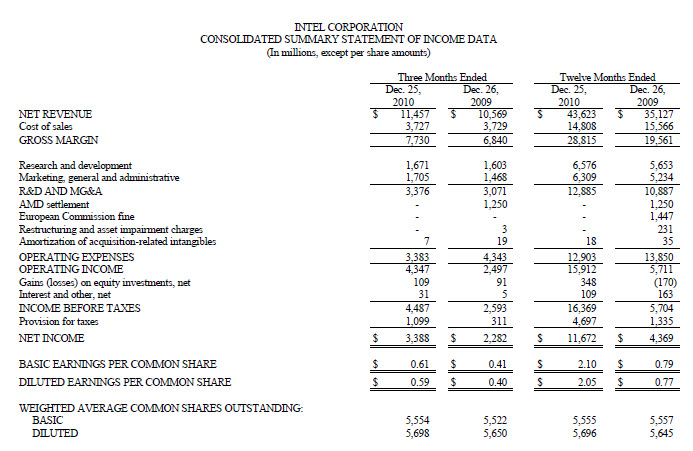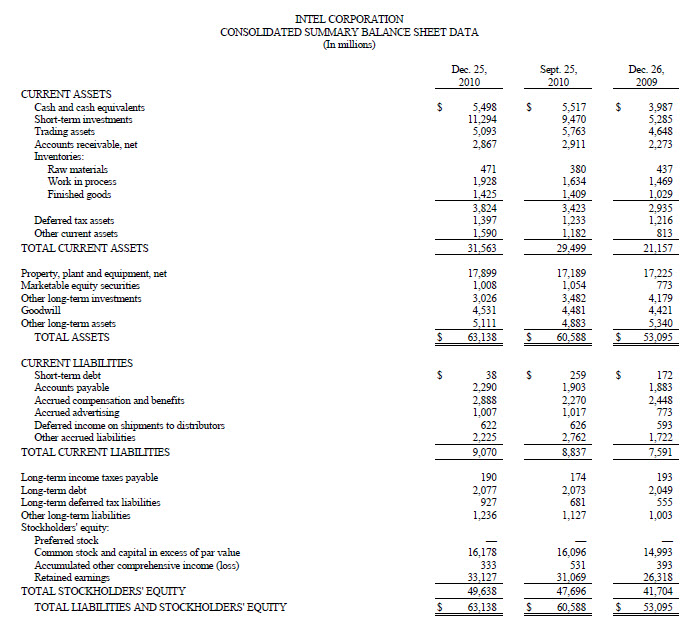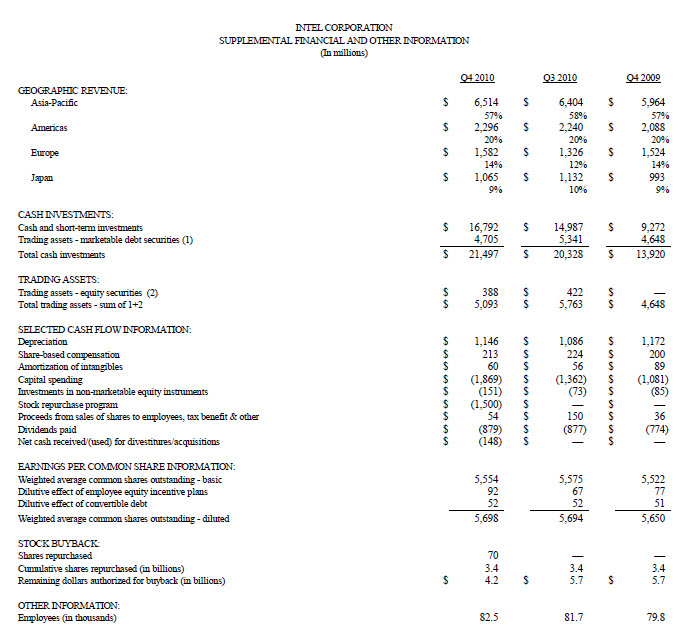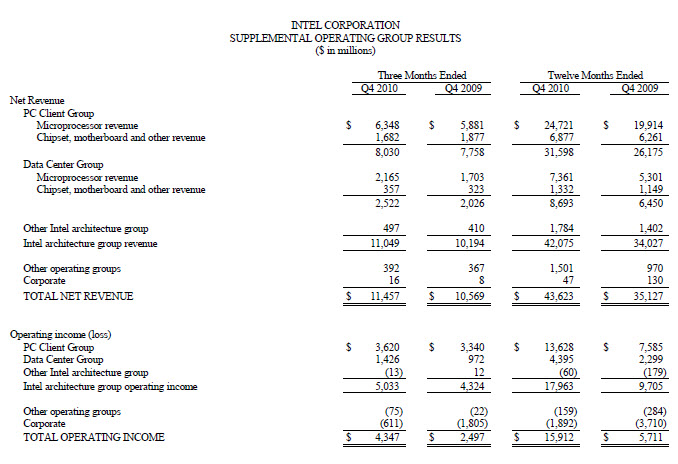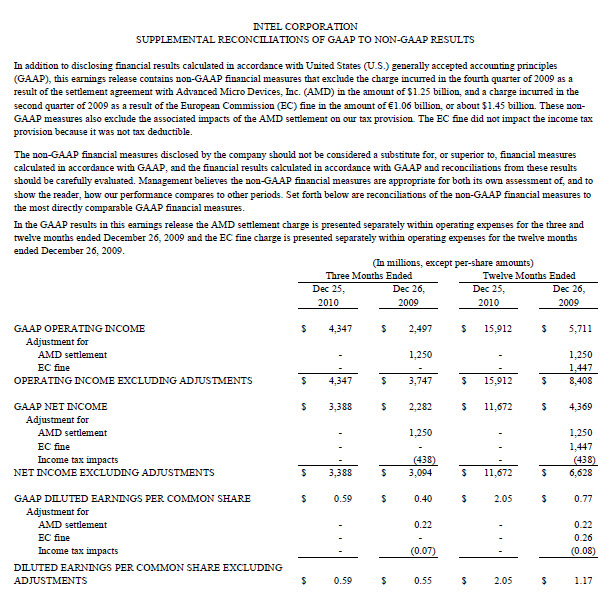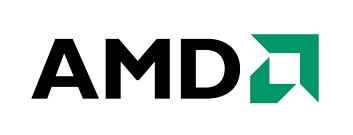
|
TopNax |
|
Back |
Intel Records Record Quarter and Record Year |
|
Intelís most recent quarterly earnings report has revealed that Q42010 was a record breaker.
Intel yesterday reported on its fourth quarter earnings, detailing that net income was $3.4 billion (up $433 million) on revenues of $11.5 billion (up $355 million). This represents a record quarter for Intel with increases of 15 per cent and 3 per cent, respectively, over Q3 2010's numbers. The company also reported Q4 operating income of $4.3 billion, up $211 million, 5 percent sequentially; and earnings per share (EPS) of 59 cents, an increase of 13 percent. Comparing Q4 2010 to the same period in 2009, Intel's revenue of $11.5 billion represents an 8 percent jump over 2009, while itís operating income ($4.3 billion) and net income ($3.4 billion) represent jumps of 74 and 48 percent, respectively, over Q4 2009. Earnings per share also saw a 48 percent increase over Q4 2009. |

Intel Reports Record Year and Record Fourth QuarterFull-Year Results∑ Revenue $43.6 billion, up $8.5 billion, 24 percent year-over-year∑ Gross margin of 66 percent, up 10 percentage points year-over-year∑ Operating income $15.9 billion, up $10.2 billion, 179 percent year-over-year∑ Net income $11.7 billion, up $7.3 billion, 167 percent year-over-year∑ EPS $2.05, up $1.28, 166 percent year-over-yearFull-Year Results, Excluding the EC Fine and AMD Settlement Agreement∑ On a non-GAAP basis, operating income $15.9 billion, up $7.5 Billion, 89 percent year-over-year∑ On a non-GAAP basis, net income $11.7 billion, up $5.0 billion, 76 percent year-over-year∑ On a non-GAAP basis, EPS $2.05, up 88 cents, 75 percent year-over-year Fourth-Quarter Results∑ Revenue $11.5 billion, up $355 million, 3 percent sequentially∑ Record gross margin of 67.5 percent, up 1.5 percentage points sequentially∑ Operating income $4.3 billion, up $211 million, 5 percent sequentially∑ Net income $3.4 billion, up $433 million, 15 percent sequentially∑ EPS 59 cents, up 7 cents, 13 percent sequentially |
|
∑ SANTA CLARA, Calif., Jan. 13, 2011 - Intel Corporation today reported full-year revenue of $43.6 billion, operating income of $15.9 billion, net income of $11.7 billion, and EPS of $2.05 - all records. The company generated approximately $16.7 billion in cash from operations, paid cash dividends of $3.5 billion, and used $1.5 billion to repurchase 70 million shares of common stock. ∑ For the fourth-quarter, Intel posted revenue of $11.5 billion. The company reported fourth-quarter operating income of $4.3 billion, net income of $3.4 billion, and EPS of 59 cents. Fourth-quarter revenue, operating income, net income, and EPS were also all records. ∑ "2010 was the best year in Intel's history. We believe that 2011 will be even better," said Paul Otellini, Intel president and CEO. ∑ ∑ Full-Year 2010 Key Financial Information ∑ PC Client Group revenue up 21 percent, Data Center Group revenue up 35 percent, other Intel architecture group revenue up 27 percent, and Intelģ Atomô microprocessor and chipset revenue of $1.6 billion up 8 percent. ∑ Gross margin of 66 percent, up 10 percentage points compared to 2009. ∑ Full-year capital spending was $5.2 billion, consistent with the company's expectation. ∑ The company used $1.5 billion to repurchase 70 million shares of common stock. ∑ Q4 2010 Key Financial Information ∑ PC Client Group revenue flat, Data Center Group revenue up 15 percent, other Intel architecture group flat, and Intel Atom microprocessor and chipset revenue of $391 million flat, all sequentially. ∑ The average selling price (ASP) for microprocessors was slightly up sequentially. ∑ Gross margin was 67.5 percent, slightly above the company's expectation. ∑ R&D plus MG&A spending of $3.4 billion was higher than the company's expectation. ∑ The net gain of $140 million from equity investments and interest and other was better than the company's expectation. ∑ The effective tax rate was 24 percent, lower than the company's expectation of 31 percent primarily due to the retroactive reinstatement of the U.S. R&D tax credit. ∑ Business Outlook ∑ Intel's Business Outlook does not include the potential impact of any mergers, acquisitions, divestitures or other business combinations that may be completed after Jan. 13. ∑ Q1 2011 ∑ Revenue: $11.5 billion, plus or minus $400 million. ∑ Gross margin percentage: 64 percent, plus or minus a couple percentage points. ∑ R&D plus MG&A spending: approximately $3.4 billion. ∑ Impact of equity investments and interest and other: gain of approximately $200 million. ∑ Depreciation: approximately $1.2 billion. ∑ Full-Year 2011 ∑ ∑ Gross margin percentage: 65 percent, plus or minus a few percentage points. ∑ Spending (R&D plus MG&A): $13.9 billion, plus or minus $200 million. ∑ R&D spending: approximately $7.3 billion. ∑ Tax rate: approximately 29 percent. ∑ Depreciation: approximately $5 billion, plus or minus $100 million. ∑ Capital spending: expected to be $9.0 billion, plus or minus $300 million. ∑ ∑ For additional information regarding Intel's results and Outlook, please see the CFO commentary at: www.intc.com/results.cfm. Status of Business Outlook Risk Factors ∑ Demand could be different from Intel's expectations due to factors including changes in business and economic conditions; customer acceptance of Intel's and competitors' products; changes in customer order patterns including order cancellations; and changes in the level of inventory at customers. ∑ Intel operates in intensely competitive industries that are characterized by a high percentage of costs that are fixed or difficult to reduce in the short term and product demand that is highly variable and difficult to forecast. Revenue and the gross margin percentage are affected by the timing of Intel product introductions and the demand for and market acceptance of Intel's products; actions taken by Intel's competitors, including product offerings and introductions, marketing programs and pricing pressures and Intel's response to such actions; and Intel's ability to respond quickly to technological developments and to incorporate new features into its products. ∑ The gross margin percentage could vary significantly from expectations based on capacity utilization; variations in inventory valuation, including variations related to the timing of qualifying products for sale; changes in revenue levels; product mix and pricing; the timing and execution of the manufacturing ramp and associated costs; start-up costs; excess or obsolete inventory; changes in unit costs; defects or disruptions in the supply of materials or resources; product manufacturing quality/yields; and impairments of long-lived assets, including manufacturing, assembly/test and intangible assets. ∑ Expenses, particularly certain marketing and compensation expenses, as well as restructuring and asset impairment charges, vary depending on the level of demand for Intel's products and the level of revenue and profits. ∑ The tax rate expectation is based on current tax law and current expected income. The tax rate may be affected by the jurisdictions in which profits are determined to be earned and taxed; changes in the estimates of credits, benefits and deductions; the resolution of issues arising from tax audits with various tax authorities, including payment of interest and penalties; and the ability to realize deferred tax assets. ∑ Gains or losses from equity securities and interest and other could vary from expectations depending on gains or losses on the sale, exchange, change in the fair value or impairments of debt and equity investments; interest rates; cash balances; and changes in fair value of derivative instruments. ∑ The majority of Intel's non-marketable equity investment portfolio balance is concentrated in companies in the flash memory market segment, and declines in this market segment or changes in management's plans with respect to Intel's investments in this market segment could result in significant impairment charges, impacting restructuring charges as well as gains/losses on equity investments and interest and other. ∑ Intel's results could be impacted by adverse economic, social, political and physical/infrastructure conditions in countries where Intel, its customers or its suppliers operate, including military conflict and other security risks, natural disasters, infrastructure disruptions, health concerns and fluctuations in currency exchange rates. ∑ Intel's results could be affected by the timing of closing of acquisitions and divestitures. ∑ Intel's results could be affected by adverse effects associated with product defects and errata (deviations from published specifications), and by litigation or regulatory matters involving intellectual property, stockholder, consumer, antitrust and other issues, such as the litigation and regulatory matters described in Intel's SEC reports. An unfavorable ruling could include monetary damages or an injunction prohibiting us from manufacturing or selling one or more products, precluding particular business practices, impacting Intel's ability to design its products, or requiring other remedies such as compulsory licensing of intellectual property. A detailed discussion of these and other factors that could affect Intel's results is included in Intel's SEC filings, including the report on Form 10-Q for the fiscal quarter ended Sept. 25, 2010. Earnings Webcast Intel will hold a public webcast at 2:30 p.m. PST today on its Investor Relations web site at www.intc.com. A webcast replay and MP3 download will also be made available on the site. Intel plans to report its earnings for the first quarter of 2011 on Tuesday, April 19, 2011. Immediately following the earnings report, the company plans to publish a commentary by Stacy J. Smith, vice president and chief financial officer at www.intc.com/results.cfm. A public webcast of Intel's earnings conference call will follow at 2:30 p.m. PST at www.intc.com. Intel [NASDAQ: INTC], the world leader in silicon innovation, develops technologies, products and initiatives to continually advance how people work and live. Additional information about Intel is available at www.intel.com/pressroom and blogs.intel.com Intel, the Intel logo, and Intel Atom are trademarks of Intel Corporation in the United States and other countries. * Other names and brands may be claimed as the property of others.
|

